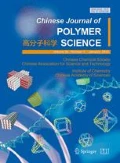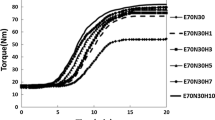Abstract
To meet the increasing demand for safe, environmentally friendly and high-performance smart materials, self-healing rubbers are highly desired. Here, the self-healing performance of ethylene propylene diene monomer rubber (EPDM) is reported, which was designed by graft-polymerization of zinc dimethacrylate (ZDMA) onto rubber chains to form a reversible ionic cross-linked network. Single ionic cross-linked network and dual network, combining covalent and ionic cross-links, could be tuned by controlling vulcanization process to achieve tailorable mechanical and self-healing properties. It was found that ionic cross-linked EPDM showed a recovery of more than 95% of the original mechanical strength through a healing process of 1 h at 100 °C. The covalent cross-links could improve mechanical properties but block self-healing. Adding 50 wt% liquid rubber to “dry” EPDM could effectively enhance self-healing capability of the dual cross-linked network and the healed tensile strength could reach 0.9 MPa. A compromise between mechanical performance and healing capability could be potentially tailored by controlling vulcanization process and liquid rubber content.
Similar content being viewed by others
References
Vèlez, J. S.; Velásquez, S.; Giraldo, D. Mechanical and rheometric properties of gilsonite/carbon black/natural rubber compounds cured using conventional and efficient vulcanization systems. Polym. Test. 2016, 56: 1–9.
Hosseini, S. M.; Razzaghi-Kashani, M. On the role of nanosilica in the kinetics of peroxide vulcanization of ethylene propylene diene rubber. Polymer, 2017, 133, 8–19.
Movahed, S. O.; Ansarifar, A.; Zohuri, G.; Ghaneie, N.; Kermany, Y. Devulcanization of ethylene-propylene-diene waste rubber by microwaves and chemical agents. J. Elastomer Plast. 2014, 48, 122–144.
Yu, B. C.; Jung, J. W.; Park, K.; Goodenough, J. B. A new approach for recycling waste rubber products in Li-S batteries. Energ. Environ. Sci. 2017, 10, 86–90.
Molanorouzi, M.; Mohaved, S. O. Reclaiming waste tire rubber by an irradiation technique. Polym. Degrad. Stab. 2016, 128, 115–125.
Keller, M. W.; White, S. R.; Sottos, N. R. A self-healing poly(dimethyl siloxane) elastomer. Adv. Funct. Mater. 2007, 17, 2399–2404.
Chowdhury, R. A.; Hosur, M. V.; Nuruddin, M.; Tcherbi-Narteh, A.; Kumar, A.; Boddu, V.; Jeelani, S. Self-healing epoxy composites: Preparation, characterization and healing performance. J. Mater. Res. Technol. 2015, 4, 33–43.
Pepels, M.; Filot, I.; Klumperman, B.; Goossens, H. Self-healing systems based on disulfide-thiol exchange reactions. Polym. Chem. 2013, 4, 4955–11.
Guo, Y. K.; Li, H.; Zhao, P. X.; Wang, X. F.; Astruc, D.; Shuai, M. B. Thermo-reversible MWCNTs/epoxy polymer for use in self-healing and recyclable epoxy adhesive. Chinese J. Polym. Sci. 2017, 35, 728–738.
Kang, J.; Son, D.; Wang, G. J. N.; Liu, Y.; Lopez, J.; Kim, Y.; Oh, J. Y.; Katsumata, T.; Mun, J.; Lee, Y.; Jin, L.; Tok, J. B. H.; Bao, Z. Tough and water-insensitive self-healing elastomer for robust electronic skin. Adv. Mater. 2018, 15, 1706846.
Liu, X.; Lu, C.; Wu, X.; Zhang, X. Self-healing strain sensors based on nanostructured supramolecular conductive elastomers. J. Mater. Chem. A 2017, 5, 9824–9832.
Luan, Y. G.; Zhang, X. A.; Jiang, S. L.; Chen, J. H.; Lyu, Y. F. Self-healing supramolecular polymer composites by hydrogen bonding interactions between hyperbranched polymer and graphene oxide. Chinese J. Polym. Sci. 2018, 36, 584–591.
Liu, J.; Liu, J.; Wang, S.; Huang, J.; Wu, S.; Tang, Z.; Guo, B.; Zhang, L. An advanced elastomer with an unprecedented combination of excellent mechanical properties and high self-healing capability. J. Mater. Chem. A 2017, 5, 25660–25671.
Jia, X. Y.; Mei, J. F.; Lai, J. C.; Li, C. H.; You, X. Z. A highly stretchable polymer that can be thermally healed at mild temperature. Macromol. Rapid Commun. 2016, 37, 952–956.
Rahman, M. A.; Penco, M.; Peroni, I.; Ramorino, G.; Grande, A. M.; Di Landro, L. Self-repairing systems based on ionomers and epoxidized natural rubber blends. ACS Appl. Mater. Interfaces 2011, 3, 4865–4874.
García-Huete, N.; Post, W.; Laza, J. M.; Vilas, J. L.; León, L. M.; García, S. J. Effect of the blend ratio on the shape memory and self-healing behaviour of ionomer-polycyclooctene cross-linked polymer blends. Eur. Polym. J. 2018, 98, 154–161.
Das, A.; Sallat, A.; Böhme, F.; Suckow, M.; Basu, D.; Wießner, S.; Stöckelhuber, K. W.; Voit, B.; Heinrich, G. Ionic modification turns commercial rubber into a self-healing material. ACS Appl. Mater. Interfaces 2015, 7, 20623–20630.
Li, C. H.; Wang, C.; Keplinger, C.; Zuo, J. L.; Jin, L.; Sun, Y.; Zheng, P.; Cao, Y.; Lissel, F.; Linder, C.; You, X. Z.; Bao, Z. A highly stretchable autonomous self-healing elastomer. Nat. Chem. 2016, 8, 618–624.
Chen, Y.; Kushner, A. M.; Williams, G. A.; Guan, Z. Multiphase design of autonomic self-healing thermoplastic elastomers. Nat. Chem. 2012, 4, 467–472.
Kalista, S. J., Jr.; Ward, T. C.; Oyetunji, Z. Self-healing of poly(ethylene-co-methacrylic acid) copolymers following projectile puncture. Mech. Adv. Mater. Struc. 2007, 14, 391–397.
Zhong, M.; Liu, Y. T.; Xie, X. M. Self-healable, super tough graphene oxide-poly(acrylic acid) nanocomposite hydrogels facilitated by dual cross-linking effects through dynamic ionic interactions. J. Mater. Chem. B 2015, 3, 4001–4008.
Xu, C.; Cao, L.; Lin, B.; Liang, X.; Chen, Y. Design of self-healing supramolecular rubbers by introducing ionic cross-links into natural rubber via a controlled vulcanization. ACS Appl. Mater. Interfaces 2016, 8, 17728–17737.
Zhang, J.; Huo, M.; Li, M.; Li, T.; Li, N.; Zhou, J.; Jiang, J. Shape memory and self-healing materials from supramolecular block polymers. Polymer 2018, 134, 35–43.
Miwa, Y.; Kurachi, J.; Kohbara, Y.; Kutsumizu, S. Dynamic ionic cross-links enable high strength and ultrastretchability in a single elastomer. Commun. Chem. 2018, 1, 5.
Peng, Z.; Liang, X.; Zhang, Y.; Zhang, Y. Reinforcement of EPDM by in situ prepared zinc dimethacrylate. J. Appl. Polym. Sci. 2002, 84, 1339–1345.
Nie, Y.; Huang, G.; Qu, L.; Zhang, P.; Weng, G.; Wu, J. Cure kinetics and morphology of natural rubber reinforced by the in situ polymerization of zinc dimethacrylate. J. Appl. Polym. Sci. 2010, 115, 99–106.
Chen, Y.; Xu, C. Cross-link network evolution of nature rubber/zinc dimethacrylate composite during peroxide vulcanization. Polym. Compos. 2011, 32, 1505–1514.
Xu, C.; Huang, X.; Li, C.; Chen, Y.; Lin, B.; Liang, X. Design of “Zn2+ salt-bondings” cross-linked carboxylated styrene butadiene rubber with reprocessing and recycling ability via rearrangements of ionic cross-linkings. ACS Sustain. Chem. Eng. 2016, 4, 6981–6990.
Xu, C.; Cao, L.; Huang, X.; Chen, Y.; Lin, B.; Fu, L. Self-healing natural rubber with tailorable mechanical properties based on ionic supramolecular hybrid network. ACS Appl. Mater. Interfaces 2017, 9, 29363–29373.
Wang, D.; Guo, J.; Zhang, H.; Cheng, B.; Shen, H.; Zhao, N.; Xu, J. Intelligent rubber with tailored properties for self-healing and shape memory. J. Mater. Chem. A 2015, 3, 12864–12872.
Cao, L.; Huang, J.; Chen, Y. Dual cross-linked epoxidized natural rubber reinforced by tunicate cellulose nanocrystals with improved strength and extensibility. ACS Sustain. Chem. Eng. 2018, 6, 14802–14811.
Xu, C.; Cui, R.; Fu, L.; Lin, B. Recyclable and heat-healable epoxidized natural rubber/bentonite composites. Compos. Sci. Technol. 2018, 167, 421–430.
Flory, P. J. Statistical mechanics of swelling of network structures. J. Chem. Phys. 1950, 18, 108–111.
Bala, P.; Samantaray, B. K.; Srivastava, S. K.; Nando, G. B. Organomodified montmorillonite as filler in natural and synthetic rubber. J. Appl. Polym. Sci. 2004, 92, 3583–3592.
Liu, X. Y.; Zhong, M.; Shi, F. K.; Xu, H.; Xie, X. M. Multibond network hydrogels with robust mechanical and self-healable properties. Chinese J. Polym. Sci. 2017, 35, 1253–1267.
Yarmohammadi, M.; Shahidzadeh, M.; Ramezanzadeh, B. Designing an elastomeric polyurethane coating with enhanced mechanical and self-healing properties- the influence of disulfide chain extender. Prog. Org. Coat. 2018, 121, 45–52.
Wool, R. P.; O’Connor, K. M. A theory crack healing in polymers. J. Appl. Phys. 1981, 52, 5953–5963.
Acknowledgments
This work was financially supported by the National Basic Research Program of China (Nos. 2015CB654700 and 2015CB654706), the National Natural Science Foundation of China (No. 51403115), and the Key Laboratory of Rubber-Plastics, Ministry of Education/Shandong Provincial Key Laboratory of Rubber-plastics of Qingdao University of Science & Technology (KF2017008). We are also grateful for the support from Hutchinson.
Author information
Authors and Affiliations
Corresponding authors
Electronic supplementary material
Rights and permissions
About this article
Cite this article
Zhang, ZF., Yang, K., Zhao, SG. et al. Self-healing Behavior of Ethylene Propylene Diene Rubbers Based on Ionic Association. Chin J Polym Sci 37, 700–707 (2019). https://doi.org/10.1007/s10118-019-2241-0
Received:
Accepted:
Published:
Issue Date:
DOI: https://doi.org/10.1007/s10118-019-2241-0




